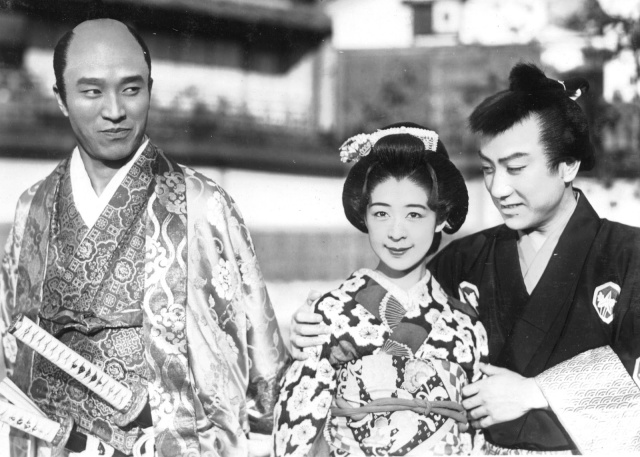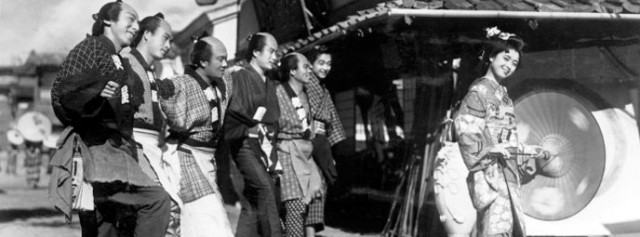
Oharu (Haruyo Ichikawa) finds herself caught between Lord Minezawa (Dick Mine) and Reisaburō (Chiezō Kataoka) in Singing Lovebirds
SINGING LOVEBIRDS (OSHIDORI UTAGASSEN) (鴛鴦歌合戦) (Masahiro Makino, 1939)
Museum of Modern Art, MoMA Film
11 West 53rd St. between Fifth & Sixth Aves.
Friday, April 13, 4:30, and Saturday, April 14, 1:30
Series runs April 12-29 at MoMA and Japan Society
212-708-9400
www.moma.org
www.japansociety.org
 In the 1930s, on the cusp of WWII, Japan was in the process of creating its own cinematic musical genre. One of the all-time classics is the wonderful Singing Lovebirds, a period romantic rectangle set in the days of the samurai. Oharu (Haruyo Ichikawa) is in love with handsome ronin Reisaburō (Chiezō Kataoka), but he is also being pursued by the wealthy and vain Otomi (Tomiko Hattori) and the merchant’s daughter, Fujio (Fujiko Fukamizu), who has been promised to him. Meanwhile, Lord Minezawa (jazz singer Dick Mine) has set his sights on Oharu and plans to get to her through her father, Kyōsai Shimura (Takashi Shimura), a former samurai who now paints umbrellas and spends all of his minuscule earnings collecting antiques. “It’s love at first sight for me with this beautiful young woman,” Lord Minezawa sings about Oharu before telling his underlings, “Someone, go buy her for me.” But Oharu’s love is not for sale. Directed by Masahiro Makino, the son of Japanese film pioneer Shōzō Makino, Singing Lovebirds is utterly charming from start to finish, primarily because it knows exactly what it is and doesn’t try to be anything else, throwing in a few sly self-references for good measure.
In the 1930s, on the cusp of WWII, Japan was in the process of creating its own cinematic musical genre. One of the all-time classics is the wonderful Singing Lovebirds, a period romantic rectangle set in the days of the samurai. Oharu (Haruyo Ichikawa) is in love with handsome ronin Reisaburō (Chiezō Kataoka), but he is also being pursued by the wealthy and vain Otomi (Tomiko Hattori) and the merchant’s daughter, Fujio (Fujiko Fukamizu), who has been promised to him. Meanwhile, Lord Minezawa (jazz singer Dick Mine) has set his sights on Oharu and plans to get to her through her father, Kyōsai Shimura (Takashi Shimura), a former samurai who now paints umbrellas and spends all of his minuscule earnings collecting antiques. “It’s love at first sight for me with this beautiful young woman,” Lord Minezawa sings about Oharu before telling his underlings, “Someone, go buy her for me.” But Oharu’s love is not for sale. Directed by Masahiro Makino, the son of Japanese film pioneer Shōzō Makino, Singing Lovebirds is utterly charming from start to finish, primarily because it knows exactly what it is and doesn’t try to be anything else, throwing in a few sly self-references for good measure.

A romantic rectangle is at the center of Masahiro Makino’s charming 1939 musical, Singing Lovebirds
Made in a mere two weeks while Kataoka was ill and needed a break from another movie Masahiro Makino was making — he tended to make films rather quickly, compiling a resume of more than 250 works between 1926 and 1972 — Singing Lovebirds features a basic but cute script by Koji Edogawa, playful choreography by Reijiro Adachi, a wide-ranging score by Tokujirō Ōkubo, silly but fun lyrics by Kinya Shimada, and sharp black-and-white cinematography by Kazuo Miyagawa, who would go on to shoot seminal films by Akira Kurosawa, Kenji Mizoguchi, Yasujirō Ozu, and Kon Ichikawa. There are fab touches throughout the film, from the comic-relief group of men who follow Otomi around, professing their love, to the field of umbrellas made by Kyōsai that resembles a mural by Takashi Murakami, to a musical number sung by Lord Minezawa in which the musicians are clearly not playing the instruments that can be heard on the soundtrack. And of course, it’s also worth it just to hear the great Takashi Shimura, who appeared in so many classic Kurosawa films, sing, although he doesn’t dance. Singing Lovebirds might not have tremendous depth, primarily focusing on money and greed, love and honesty, but the umbrellas do serve as clever metaphors for the many different shades of humanity, for places to hide, and for ways of seeking protection from a world that can be both harsh and beautiful.
Singing Lovebirds is screening April 13 and 14 in the MoMA / Japan Society series “Kazuo Miyagawa: Japan’s Greatest Cinematographer,” which runs April 12-29 at both venues and includes such other Miyagawa-photographed gems as Hiroshi Inagaki’s rarely shown The Rickshaw Man, Yasujirô Ozu’s Floating Weeds, Kenji Mizoguchi’s Tales of the Taira Clan, and Kozaburo Yoshimura’s Bamboo Doll of Echizen in addition to works by Daisuke Ito, Akira Kurosawa, Kon Ichikawa, Kazuo Mori, Masahiro Shinoda, Kazuo Ikehiro, Yasuzô Masumura, and Kenji Misumi. Miyagawa passed away in 1999 at the age of ninety-one, having shot more than eighty films over a fifty-year career. This first major U.S. retrospective of his work, which explores his innovative techniques with the camera and influential legacy, was organized by MoMA’s Joshua Siegel and Japan Society’s Aiko Masubuchi and Kazu Watanabe. In conjunction with the series, Film Forum is showing new 4K restorations of Mizoguchi’s Sansho the Bailiff and A Story from Chikamatsu through April 12. As a bonus, Japan Society is hosting the talk “Cinematographer, Kazuo Miyagawa” on April 14 at 3:00 (free with any series ticket), with Miyagawa’s eldest son, Ichiro Miyagawa, and Miyagawa’s longtime camera assistant, Masahiro Miyajima, moderated by Joanne Bernardi.